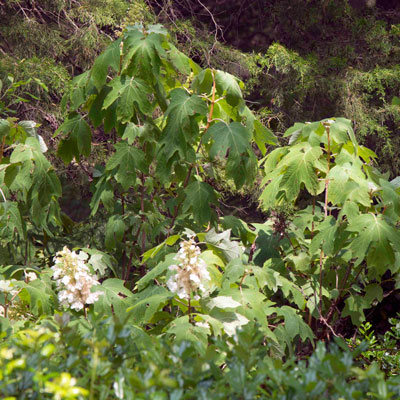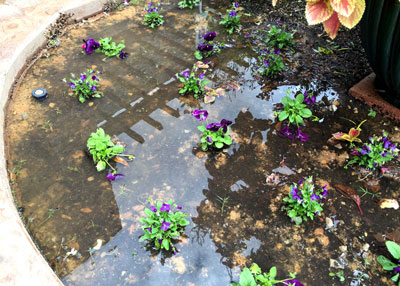Over-watering? Under-watering? How to Tell the Difference

Photo: Oakleaf hydrangea in the Sperry backyard earlier this week seems to be wilting. You’ll have to read the entire story to see what’s causing this to happen.
Here’s what I hear quite often…
The question/comment starts something like this: “Neil, I think I’ve over-watered my plant.” And that’s when my journey to the solution begins. But I’m going to help you find a very useful shortcut. See if you can tell the difference in these two stacks of symptoms.
Under-watering…
• Plant is wilted.
• Leaves may be folded or rolled.
• Soil is dry to the touch an inch or more into the ground.
Over-watering…
• Plant is wilted.
• Leaves may be folded or rolled.
• Soil remains wet, even soggy.
Did you see the difference?
Yep! Let the soil be your guide. If it’s already wet and has been so for several hours, yet the plant is still wilted, that plant’s roots are probably “drowning.” While the ideal soil consists of 50 percent solid matter, 25 percent water and 25 percent air (with critical oxygen), a waterlogged soil is 50 percent solid matter and 50 percent water. There is no oxygen. Water has replaced it.
Sometimes this happens when the soil is simply poorly drained. Your solution: plant in raised beds and/or cut swales or install grates to improve the surface runoff.

Photo: Pansies in this photo taken during late fall had little chance of surviving. There is apparently no way for rainfall to escape from this small bed.
Sometimes this can happen with container gardens when you have plants sitting on top of the ground. Roots may grow out the drain holes and end up closing it shut. Water will accumulate in the pot and the plant may go downhill quickly. The solution: elevate the pot off the ground by placing it atop a couple of bricks.
An exception to my comments…
There are times when a plant is perfectly watered (not waterlogged and not dry), yet it still wilts. That’s the case with the oakleaf hydrangea I photographed a couple of days ago in our home landscape.
Some plants have very large leaves and they’re not able to pull water through their roots, up their stems and out through the leaves rapidly enough to keep up with the needs. If the sun strikes them, they may wilt for a short while – generally until they’re back in the shade.
I see it with all of my oakleaf hydrangeas if the sun passes over them for a few minutes. I see it with tomatoes if we’ve had a few days of cloudy weather followed by bright sunshine. And I see it with a few other plants from time to time.
But that’s where your experience as a gardener will cover those bases. You’ll learn the steps. You’ll check the soil. You’ll check the sunshine. You’ll think back to the past days to recall if they were consistently cloudy. You’ll water if you need to. Then you’ll sit back and watch.
